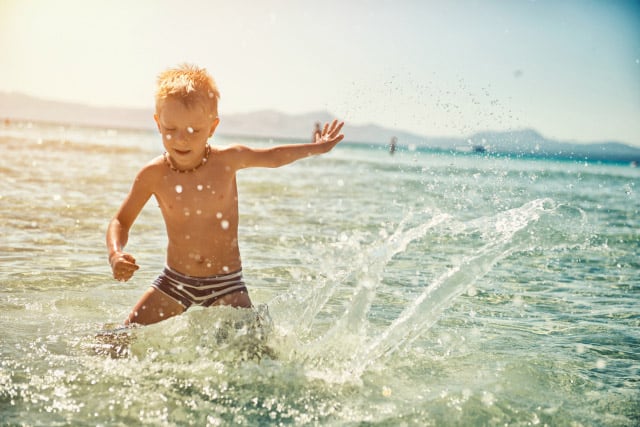4 Tips for Effective Sun Safety This Summer

Many people look forward to the summer because they can enjoy vacations, sunshine and outdoor activities. A little bit of sun won’t hurt you, but too much sun exposure can cause wrinkles, premature aging of the skin and skin cancer.
In fact, skin cancer is the most common form of cancer in the U.S., according to the American Cancer Society. According to the American Cancer Society, about 3.5 million cases of basal and squamous cell skin cancer are diagnosed the U.S. each year.
In 2015, more than 73,000 Americans will be diagnosed with melanoma, a more dangerous form of skin cancer.
It’s important to practice good sun safety behaviors to help protect your skin.
Pick a sunscreen
The goal of sunscreen is to prevent the sun’s ultraviolet (UV) radiation from reaching your skin. UVA and UVB rays are the two types of ultraviolet radiation.
UVB rays are typically associated with sunburn, while UVA rays are associated more with wrinkled and leathery-looking skin.
A sun protection factor, or SPF, is a measure of a sunscreen’s ability to prevent UVB rays from damaging your skin.
Most sunscreens with SPF of 15 or higher do a good job of protecting your skin from UVB rays, according to the Skin Cancer Foundation, an organization dedicated to educating people on sun safety.
No sunscreen can block UV rays completely, but according to the Skin Cancer Foundation:
- SPF 15 blocks 93 percent of UVB rays.
- SPF 30 blocks 97 percent.
- SPF 50 blocks about 98 percent.
It’s best to pick a ‘broad-spectrum’ sunscreen with an SPF of 30 to 50,” says Robert Polisky, dermatologist at Elk Grove Dermatology in Illinois. Broad-spectrum sunscreens have the ability to block both UVA and UVB rays.
“It’s also important to know your own skin type,” Polisky adds. Dermatologists assess a person’s skin type, including his or her risk of getting skin burns and developing skin cancer. For example, a person with red hair, blue eyes and fair skin may opt for a higher SPF to help prevent skin cancer.
Sunscreens come in a variety of lotions, creams, sprays and sticks. “The best sunscreen is the one that you’ll actually use,” says Melissa Piliang, dermatologist at the Cleveland Clinic in Ohio.
There are mixed thoughts about using sunscreens with an SPF of 75 or more. The (FDA) is recommending that future SPF labeling only go up to 50.
Always remember to put on a thick coat of sunscreen and reapply every two hours throughout the day, especially if you’re going to be outside for long periods of time or swimming.
Keep children and older adults educated
The best way to get kids used to wearing sunscreen and protective clothing is to start them early,” Piliang says. A parent’s goal should be to make sun protection a habit — like wearing a seat belt.
Americans over the age of 50 have an increased risk for developing skin cancer because they typically have more sun exposure over time compared with a younger person.
Also, skin is more prone to damage as we age. How often your doctor conducts a skin check will depend on your skin type, past sun exposure and family history.
In the meantime, you should pay attention to any moles that change, skin lesions that bleed or pimples that don’t heal easily. These are all potential signs of skin cancer.
Additionally, hair thins for both men and women as they age, making scalps more prone to sun damage. “Use sunscreen on your head and be sure to wear hats,” Piliang says.
There are some sunscreens that are specifically made for hair; however, you can also use a regular sunscreen that comes in a spray form. This may be easier to apply and less messy on your hair and scalp.
Wear sun-protective clothing
Wearing hats, sunglasses and ultraviolet protection factor (UPF)-rated clothing can also protect against harmful sun rays.
UPF is a rating system used for clothing. Clothes with UPF ratings can be found online or at sporting and outdoor stores like REI or Sierra Trading Post.
The UPF tells you how well a piece of clothing protects you from UV rays. The higher the UPF number, the greater degree of UV protection you’ll get. UPF ratings range from 15 to 50+. This rating can typically be found on the clothing label.
Clothes that have a UPF rating of more than 40 are considered “excellent” protection from the sun.
4 tips to stay safe in the sun
Using clothing and sunscreen are important for everyone, but especially for people with medical conditions such as lupus, which makes people sensitive to the sun.
“Boaters and skiers also have to be careful because sun rays can reflect off of water and snow, making it easier for people to get sunburned,” Polisky says.
Here are four general tips for staying sun safe.
- Avoid the sun between 10 a.m. and 2 p.m., when the sun rays are most intense.
- Wear hats, sunglasses and other sun-protective clothing.
- Seek shade when outside for long periods of time.
- Always use sunscreen and remember to reapply every two hours or more often if you’re swimming or sweating).
Keep your family healthy and safe by getting free health insurance quotes from multiple insurance companies today.
